NNX16AB89A
NASA, Texas Space Grant Consortium, and The University of Texas at Austin Center for Space Research Summer Intern Program is a nationally competitive STEM internship for high school students. The program provides selected students with exposure to Earth and space science research. Interns will learn how to interpret NASA satellite data, assist with mission planning, and conduct planetary science research while working with NASA subject matter experts in their chosen area of work. The summer internships are offered to motivated high school students from across the nation who have an interest in pursuing Science, Technology, Engineering, or Mathematics careers. The interns will work beside NASA subject matter experts analyzing and visualizing data. This content knowledge, coupled with hands-on experiences, allows the intern to gain experience in authentic NASA research through field investigation and data analysis. Normally, students complete 60-90 hours of remote work prior to the residential two-week program at The University of Texas. Due to the pandemic the hybrid program was moved to a fully virtual program. We will share strategies for engagement including advantages and adaptations that were made due to COVID with a positive opportunity for the additional 250 students reached.


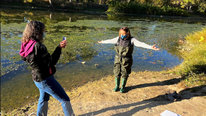
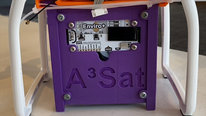
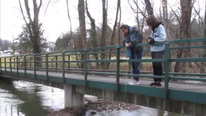
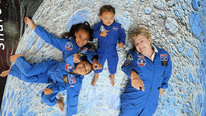
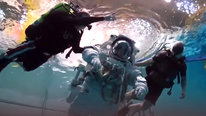
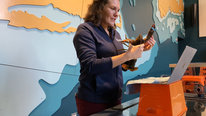
Margaret Baguio
Program Manager
SEES High School Internship Challenges/Adaptations due to COVID
NASA, The University of Texas at Austin Center for Space Research Summer Intern Program, and Texas Space Grant Consortium is a nationally competitive STEM internship for high school students. The program provides selected students with exposure to Earth and space science research. Interns learn how to interpret NASA satellite data, assist with mission planning, and conduct planetary science investigations while working with NASA subject matter experts in their chosen area of work.
The summer internships are offered to motivated high school students who have an interest in pursuing Science, Technology, Engineering, or Mathematics careers. The interns work beside NASA subject matter experts analyzing and visualizing data. This content knowledge, coupled with hands-on experiments, allows the intern to gain experience in conducting authentic NASA research through field investigation and data analysis.
Normally, students complete 60-90 hours of remote work prior to the residential two-week program at The University of Texas. Due to the pandemic the hybrid program was moved to a fully virtual program. We are happy to share strategies for engagement including advantages and adaptations that were made due to COVID, with the most positive result: increasing the number of participants.
We welcome ideas for scheduling, keeping students engaged and motivated in a virtual environment, and methods for maximizing the benefit.
Jessica Moon
This sounds like such an amazing program! Your students all seem so excited and positively-impacted by their experiences with SEES!
How did you handle the move from hybrid to completely virtual? Did you try anything that seemed to work particularly well for fostering a similar level of collaboration to what you would normally have in your hybrid model?
Margaret Baguio
Program Manager
Hello Jessica: Thanks for the great question. When we moved to a completely hybrid program the students selected were obviously disappointed. Those selected for the onsite portion of the program did not get to travel to Texas and have the university experience nor did they get to visit NASA Johnson Space Center and tour facilities, meet astronauts, and hear from NAS subject matter experts.
We added a NASA subject matter expert speaker series to the internship so students could hear from experts and share the excitement of NASA missions, exploration, and opportunities. We keep the virtual groups small to provide direct interaction with their mentors on a regular basis. Each team selected the virtual platform that best fit the project and the team members. We utilized zoom for the NASA Speaker Series.
Teams also used google meet, basecamp, and Edmoto as platforms. The mentors went above and beyond to provide the best possible experience, even if virtual. They trained students utilizing CAD software, microscopes on cell phones for mosquito investigation, and even virtual tours of NASA laboratories.
The positive was we increased our participation. The negative was many students tried to multi-task while doing the internship so they were not as focus as in previous years. For example, they took summer courses that may have conflicted with their research time.
Thanks for the question!
Jessica Moon
Thank you for your response! Our program includes a teacher training program over the summer that also went from hybrid to completely virtual last summer. The platforms you mentioned sound great for keeping everyone organized and on the same page.
Margaret Baguio
Program Manager
Thanks Jessica! Our teacher professional development institute will be all virtual this summer as NASA Johnson Space Center is only open to essential employees. We will be utilizing multiple platforms and also sending materials for experiential activities.
Yolanda Abel
Associate Professor
Margaret and Jessica, thank you for getting this strand off to a great start. Were there challenges around broadband access for the students? If so, how did the students and/or program deal with it? I live in Baltimore and in this past year as schools were remote broadband access and speed were critical issues for students in the city.
Celena Miller
Senior Program Coordinator
Hi Yolanda: That’s a great question. We polled the students three months prior to inquire if they had access to a computer and broadband internet. We were fortunate that for the 2020 SEES we did not have any students that did not have access to broadband internet. This year we have asked any student without access to a computer or broadband internet to inform us and we will provide equipment that can be checked out for use to include mobile hot spots and computers. For this, we have an equipment check out form that both the students and parents are required to sign.
Gerhard Salinger
Former Program Officer (NSF)
SEES enhances student interest in further study in science and doing research. How big is the program and how long has it been going on? Do you have data on how the internship impacted interns in the long run? Could you describe the 60 to 90 hours of remote work prior to the internship and what role it played in the internship? How did this change in the virtual internship? What have you lost and gained by being virtual?
Celena Miller
Celena Miller
Senior Program Coordinator
Great questions Gerhard! Let me start with the program overview.
Through a partnership of institutions and organizations that support STEM education, the Summer Intern Program effort began in 2010 as a three-year cooperative Education/Public Outreach (EPO) extension of several CSR NASA ROSES awards (Research Opportunities in Space and Earth Science). Subsequent years were made possible by a combination of GRACE outreach funding and TSGC support. Evolution of the program continued in 2015 with a new NASA award that brought the newly named SEES program to a national audience.
For the original on-site SEES program, fifty interns are chosen on the basis of their academic records, written application, recommendation letter, and video highlighting their interest in STEM. Each selected intern was placed into a team with a scientist mentor. They completed 60 hours of distance learning activities that must be accomplished prior to the residential internship. The two-week residential internship is where interns must be on-site at The University of Texas Center for Space Research. The internship included daytime research activities, experiential learning activities, evening STEM activities, and field investigation. The residential internship gives students the opportunity to experience college life by living in a dorm, participating in activities, and eating in the cafeteria. Each year, several teachers and graduate students are selected as chaperones for the SEES program and support activities and are with the interns during the time they are on campus. The primary focus of the internship is for the students to learn how to interpret NASA data while working with scientists and engineers in their chosen area of work in the hopes that these students will major in STEM when they go to college.
A total of 90 hours of instruction prepares the student for the internship. 30 hours of instruction on NASA earth science content including NASA Eyes, Orbital Mechanics, Space Race, Remote Sensing, My NASA Data, GRACE, ICESat, Cryosphere, Science on a Sphere, EM Spectrum, Chasing Pluto, Kepler, and Astrobiology, 30 hours for three-levels of Python coding, and an additional 30 hours of subject-matter content to prepare students for their individual projects.
Celena Miller
Senior Program Coordinator
With the onset of the COVID 19 Virus, the shutdown of many facilities including NASA centers and universities as a response to the COVID 19 restrictions created a dilemma for the future of the 2020 program. Transitioning to a virtual environment created a rare opportunity to expand our reach to many more exceptional U.S. students from around the world. In response, the program was reorganized and reimagined to create a full virtual SEES internship experience for the top 50% of student applicants. The 60 original students from previous years grew to a total of 333 high school sophomores and juniors from 45 US states, 1 territory, and 2 from oversees.
In previous years, pre-internship activities would begin with 60-90 remote work hours prior to coming to the university with limited mentor contact. Mentors would hold one introductory meeting in a virtual environment, but any interaction with the students aside from that meeting was limited to email questions regarding the remote work. However, in the 2020 SEES Virtual Internship environment, the project mentors worked through a remote classroom with the interns to support and complete the work as a team. The students were able to complete the pre-internship lessons working alongside their mentors to prepare them with the tools they needed to navigate through the virtual internship. This method not only allowed us to expand our reach but was advantageous to both the students and the NASA SME.
The differentiated Python course was migrated to Basecamp software platform to create an all-in-one toolkit for the interns to working remotely. Mentors and undergraduate volunteers offered their Python expertise to answer questions and verify coding projects. Over 300 students completed the Python certification course, with 79 working through all three levels to complete the advance certification.
To mimic the on-site lecture discussions, students participated in a Virtual Speaker Series where they were able to interact with subject matter experts in a wide range of topics related to their projects. During the speaker presentations, there was a cumulative total of over 1,100 attendees over the 11 subject matter expert presentations. Students were guided in career and degree discovery as well as their exploration of material that related to their research.
The internship concluded with student research teams presenting their projects to an audience of UT scientists and engineers, as well as other interns and their guests via a live Zoom webinar and Q&A. Over the course of two days, 82 team projects presented to a live audience. Student projects were prerecorded with students “in the wings” ready to answer the live questions being asked by the audience and their peers. The webinars were a huge success with over 3000 views in the last few months with a duration of three hours.
The live public event was broadcast as a two-day event on YouTube, 2020 SEES Virtual Showcase, with presentations by selected research teams from each project. The 2020 presentations were broadcast for a national audience and can be viewed here:
https://www.youtube.com/watch?v=pjAhHMU3e74&...
Celena Miller
Senior Program Coordinator
Four methods were used to provide annual evaluation of progress toward attaining the anticipated outcomes of SEES Virtual Internship:
SEES records were independently reviewed and the analysis provided an assessment of progress toward the desired outcome to increase the number of underserved populations pursuing careers in STEM related fields. Interviews with the program’s mentors were conducted to obtain feedback that will influence modifications in programming for next year. All SEES participants were surveyed for their evaluation of the program. Descriptive statistics and criterion references were applied to the survey items with categorial response options, and a six-step method of thematic analysis was applied to narrative responses to open-end survey items. Lastly, outcome mapping was used to obtain success stories to evaluate outcomes of the influence of the virtual summer internships on the students selected.
For 5 years, students will be contacted and monitored annually to provide individually in their own words a brief summary of (a) Student’s Accomplishments/Awards (b) Student’s Internships (c) impact TSGC support had on student in their career or future goals. This approach will provide a powerful thematic description of outcomes and enables a quantitative estimate of the overall success of the virtual internship.
Regarding specific areas of STEM knowledge and skills, more than half indicated their experience in the SEES experience contributed to “very much” to their development in specific domains of STEM knowledge and skills indicative of scientific literacy tabulated this year. In a follow-on survey of interns by the external evaluator, regarding specific areas of STEM knowledge and skills, more than half indicated their experience in the SEES program contributed “very much” to their understanding of scientific process, their knowledge of earth processes, and other aspects of their knowledge, skills, and personal development.
In a comparison of student evaluations when SEES was conducted on-site to the virtual program, we found: students wanted the face-to-face experience, students did not experience the college life of living in the dormitory, lack of opportunity to visit NASA Johnson Space Center and visit laboratories, scientists, and engineers was a disappointment to many and often a once-in-a-lifetime opportunity that was missed, students lacked the opportunity to work in collaborative groups to utilize the 3D print lab, robotics tools, and field investigations.
Kimberly Arcand
The students interviewed all seem so confident and positive. Do you find that across the board with your participants? This video makes me want to read more about their student projects.
Celena Miller
Senior Program Coordinator
Hi Kimberly: We do find that some students that enter the internship are already confident speakers. However, we have discovered that the relationships the students develop within their team coupled with mentor leadership on understanding scientific/earth processes and building knowledge through research on their specific topic really helps to build confidence, personal development, increases their emotional intelligence and of course their leadership skills. The students put a lot of work into their research and are very confident in their skills to express their work.
Follow-on evaluation results show that 95% of SEES participants are in college majoring in a STEM degree like Aerospace Engineering, Astrophysics, Physics, Mechanical Engineering, Computer Science, Mathematical and Computational Science, and Biomedical Engineering just to name a few.
Please feel free to watch through some of our SEES student presentations: https://www.youtube.com/watch?v=pjAhHMU3e74
Sara Mierzwiak
So great to see past SEES interns. One of our own students from GLOBE Mission EARTH was involved in the past, and I know personally it was such a rewarding experience for her. Is there any planned interaction between past interns and current ones? Nice video! ~ Sara
Celena Miller
Senior Program Coordinator
Hi Sara: We l love our current interns to keep in touch and interact with SEES Alumni as well as their mentors. We have a SEES Alumni social media page where we post opportunities for current and past interns. As part of our Speaker Series, we have a SEES Alumni Panel where we hear from former SEES interns about their SEES experience, the value of SEES, and where they are now. We will also have SEES Alumni return to mentor students through their Pre-coursework lessons, including Python and CAD. Thank you for the excellent question!
Yolanda Abel
Associate Professor
Celena, this is great! I think it is a great testimony of the effectiveness of a program when alumni want to be actively involved with it.
Joselina Cheng
Professor
Hi,
Your pre-internship lessons with mentors working alongside with student participants are very strategic to better prepared our youth for participating in the highly competitive global workforce on the human-computer society. Can you elaborate on what types of partnerships and tools to help students navigate through the virtual internship? Thanks,
Celena Miller
Senior Program Coordinator
Hi Joselina- Great question! Interns used tools such as Galaxy Zoo galaxy classification, CAD, Python, QGIS, Google Earth Engine, MultiSpec, Python, JavaScript, and satellite data from GRACE and ICESat-2. Interns also accessed and analyzed data using online tools such as the GLOBE Advanced Data Access Tool, Collect Earth Online, AppEARS, NASA Worldview, Climate Engine, Google Earth Engine and ArcGIS Online. Students collaborated and worked remotely with NASA SMEs and team members through Skype, Google classroom, Base Camp, and Zoom. The SEES High School Summer Intern Program is in partnership with NASA Cooperative Agreement Notice NNH15ZDA004C Award NNX16AB89A.
Ning Wang
Nice program! Thanks!
Margaret Baguio
Program Manager
Thank you so much. We are honored to work with these amazing students, our future scientists and engineers!
Haley Smith
90% of students in STEM majors is an amazing success - bravo! What kind of follow-up, if any, is done by the SEES program to see if alums ultimately graduate with a STEM major, plan to go on to a STEM career, etc.? And what types of resources and guidance are provided to students who come out of the program to promote their sense of belonging and success in a STEM field?
Margaret Baguio
Program Manager
We utilize a variety of methods to follow students have their SEES internship. For example, Linkedin, emails to students and/or parents, project mentors, and references. Participants seem to stay in contact with their individual project mentors more than program managers, unless they want letters of recommendation for college or internships. SEES Alumni share how the experience led to college majors and career plans during a This Is Me program and during the Speaker Series.
We have former SEES students who have interned at NASA Jet Propulsion Lab analyzing Cassini data, worked for Boeing during the summer, became Google interns, and were NASA co-ops at the Kennedy Space Center, all while pursuing their college degrees.
The first group of students selected for the SEES internship are graduating from college this year so we will be conducting a survey about careers later in the year.
Oludare Owolabi
Very good program that will motivate young ones to be interested in STEM
Margaret Baguio
Program Manager
Thank you Oludare: We are proud to work with these amazing young people.
Sriram Elango
As a current intern in this program, I can personally say that this program is wonderful and is enabling me to further pursue my interest in STEM on a much deeper level! The information taught is plentiful/amazing and I am looking forward to conducting research throughout the summer and learning even more from experts!